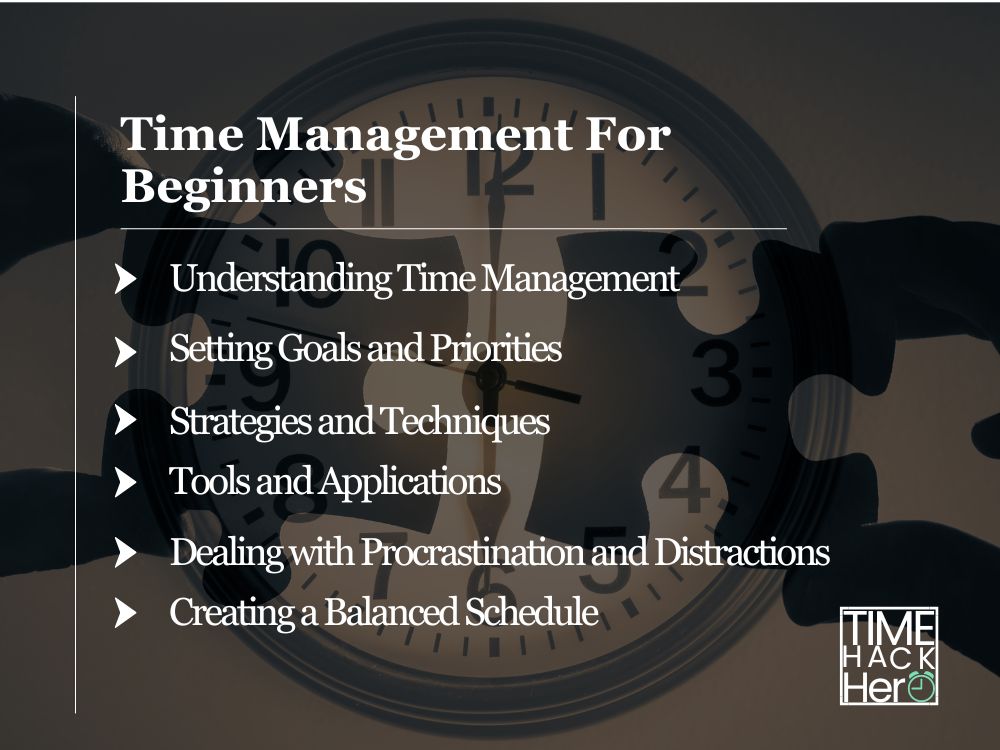In today’s fast-paced world, effective time management is essential for anyone looking to improve their productivity and achieve their goals. For beginners, learning the basics of time management can be the key to unlocking their full potential. By developing good time management skills, beginners can efficiently prioritize tasks, create a balanced schedule, and adapt to unexpected changes, all while minimizing stress and maximizing productivity.
Time management strategies come in many forms, allowing learners to choose the approaches that work best for their individual needs. Some effective methods include timeboxing, which allocates specific time slots to tasks, prioritizing tasks based on importance, and identifying and eliminating distractions. As beginners become more proficient in these techniques, they not only find themselves completing tasks more efficiently, but also gaining confidence in their ability to manage their time effectively.
Furthermore, investing in time management tools and resources can be instrumental in helping beginners develop these crucial skills. From online courses to productivity apps, there are countless options available for those eager to elevate their time management prowess. By taking advantage of these resources and consistently honing their skills, beginners can gradually progress from novices to time management experts.
Table of Contents
Understanding Time Management
Importance of Time Management
Effective time management is crucial for both personal and professional success. It enables individuals to be more productive, achieve goals, and maintain a healthy work-life balance. By effectively managing their time, individuals can focus on completing tasks efficiently, without feeling overwhelmed or burned out.
Some benefits of time management include:
- Increased productivity: Effective time management strategies allow individuals to accomplish more tasks in a shorter period of time.
- Reduced stress: When individuals are in control of their schedules, they can create a more balanced and fulfilling life.
- Improved decision-making: Being aware of the time constraints helps individuals make better choices and prioritize tasks based on urgency and importance.
Time Management Skills
Time management is not just about getting things done, but also about how efficiently and effectively they are completed. There are several key skills that contribute to successful time management:
- Prioritization: Knowing what tasks are important and which can be completed later is crucial in time management. By categorizing tasks based on urgency and importance, individuals can allocate their time and resources efficiently.
- Goal setting: Setting clear and realistic goals helps individuals stay focused, motivated, and on track. Goals should be specific, measurable, achievable, relevant, and time-bound (SMART).
- Task delegation: Effective time management often means knowing when to delegate tasks to others. This frees up time for individuals to focus on the most important tasks and helps prevent burnout.
- Organization: Keeping a tidy workspace, calendar, and to-do list can aid in time management. An organized system helps individuals to find information quickly and focus on the tasks at hand.
- Time management strategies: Employing strategies like timeboxing, the Pomodoro Technique, or the Eisenhower Matrix can help individuals stay on track and maintain a steady workflow.
- Adaptability: Flexibility is important for successful time management. Individuals should be able to quickly adapt to changes and adjust their schedules accordingly.
By developing these skills and using proven strategies, individuals can improve their efficiency and productivity while reducing stress and creating a healthier work-life balance. Remember to regularly review and adjust time management plans to find the best approach for personal and professional success.
Setting Goals and Priorities
Distinguish Between Urgent and Important
Being able to differentiate between urgent and important tasks is crucial in managing your time effectively. Urgent tasks are those that require immediate attention, whereas important tasks contribute to your long-term goals. To help you prioritize, use the Eisenhower Matrix:
| Important | Not Important | |
|---|---|---|
| Urgent | 1 | 3 |
| Not Urgent | 2 | 4 |
- Important and Urgent (Quadrant 1): These tasks require immediate attention and should be prioritized.
- Important, but Not Urgent (Quadrant 2): Spend most of your time working on these tasks as they contribute to your overall goals.
- Urgent, but Not Important (Quadrant 3): Delegate or limit the time you spend on these tasks.
- Not Urgent and Not Important (Quadrant 4): Minimize or eliminate these tasks from your schedule.
Creating a To-Do List
A to-do list helps you stay organized and focused on your daily responsibilities. Follow these steps to create an effective to-do list:
- Write down all your tasks and responsibilities for the day.
- Break larger tasks into smaller, manageable sub-tasks.
- Include deadlines and time estimates for each task.
- Group similar tasks together.
By creating a to-do list, you’ll have a clear overview of everything you need to accomplish and be able to track your progress throughout the day.
Prioritizing Tasks
Once you have a to-do list, use these methods to prioritize your tasks:
- The ABC Method: Assign a letter to each task based on its importance (A = most important, B = moderately important, C = least important). Work on your A tasks first, followed by B tasks and then C tasks.
- The 80/20 Rule: Focus on the 20% of tasks that will yield 80% of the desired results. This method allows you to concentrate on tasks that have the most significant impact on your goals.
Remember to review your priorities regularly and adjust your list as needed. By setting goals and priorities, you’ll be able to allocate your time more effectively and achieve better long-term results.
Strategies and Techniques
Effective time management is crucial for personal and professional success. As a beginner, it’s important to understand and explore several strategies and techniques to determine the best fit for your unique needs. In this section, we will discuss four key time management techniques: Time Blocking, Eisenhower Matrix, Pomodoro Method, and Swiss Cheese Method.
Time Blocking
Time blocking is a technique where you allocate specific time slots to tasks and activities. This approach helps you focus, minimize distractions, and achieve better results. To implement time blocking:
- Identify your priorities and tasks.
- Estimate the required time for each task.
- Schedule time for these tasks in your calendar.
- Stick to the schedule and move on to the next task when the time runs out.
Eisenhower Matrix
The Eisenhower Matrix is a prioritization method that helps you categorize tasks based on their urgency and importance. It consists of four quadrants:
- Urgent and important: Tasks requiring immediate attention and contributing to your long-term goals.
- Important, but not urgent: Tasks you should plan and schedule for later.
- Urgent, but not important: Delegate or outsource these tasks when possible.
- Neither urgent nor important: Consider eliminating or minimizing these tasks.
To use the Eisenhower Matrix, list your tasks and assign them to the appropriate quadrant. This will help you determine which tasks to tackle first and which to postpone or delegate.
Pomodoro Method
The Pomodoro Method is a time management technique that breaks work into intervals (usually 25 minutes) with short breaks in between. These intervals are called “pomodoros”. Follow these steps to apply the Pomodoro Method:
- Set a timer for 25 minutes.
- Work on a task until the timer rings.
- Take a 5-minute break.
- Repeat the process. After completing four pomodoros, take a longer break (15-30 minutes).
This approach can help you maintain focus, reduce burnout, and achieve a balanced workflow.
Swiss Cheese Method
The Swiss Cheese Method involves tackling large tasks by breaking them into smaller, manageable tasks. This approach allows you to make progress on a project without feeling overwhelmed. To apply the Swiss Cheese Method:
- Identify a large task or project.
- Break it down into smaller tasks or steps.
- Work on these tasks whenever you have small pockets of time.
By using this method, you’ll gradually complete the project without feeling discouraged by its size.
Tools and Applications
Calendars and Planners
Calendars and planners are essential in helping you organize your time by allowing you to set appointments, deadlines, and reminders. Some popular digital calendars include Google Calendar and TimeTree. Digital planners, like Asana, allow you to create a detailed time management plan with tasks assigned to specific dates and times.
Task Management Tools
Managing tasks efficiently is crucial for effective time management. There are several task management tools that can assist you:
- Todoist: A popular tool that allows you to create, organize, and prioritize tasks, set deadlines, and track your progress.
- Trello: A project management tool based on Kanban boards. It’s perfect for organizing tasks and collaborating with multiple people on team projects.
- Remember the Milk: A multi-platform task management tool that’s compatible with multiple devices, aiding in synchronizing your tasks.
Time Management Applications
Time management apps help to boost productivity and maintain focus. Some popular options include:
- Pomodoro Technique: A method that involves breaking work into short, focused intervals (usually 25 minutes), separated by short breaks. Tools like Forest and Focus@Will incorporate the Pomodoro technique.
- Toggl Track: A time tracking app that assists in organizing your work schedule and monitoring the time spent on tasks. Interested users can try Time Doctor as an alternative.
- RescueTime: An app that tracks your computer usage and provides reports on your most time-consuming activities, making it easier to identify time-wasters and adjust your habits.
This section offers a brief insight into the different tools and applications available for improving time management. Choose the ones that work best for your personal preferences and working style.
Dealing with Procrastination and Distractions
Identifying Time-Wasting Activities
The first step in dealing with procrastination and distractions is identifying activities that are consuming your time without adding value. Make a list of your daily activities and analyze where you are spending most of your time with no significant output. Some common time-wasting activities include:
- Excessive social media browsing
- Multitasking
- Unfocused web browsing
- Lengthy, unproductive meetings
Minimize Distractions
After identifying time-wasting activities, take action to minimize distractions in your workspace and daily routine. Some tips for minimizing distractions are:
- Set boundaries for activities that can be a distraction (e.g., checking emails only at specific times during the day)
- Delegate tasks when possible
- Avoid multitasking
- Create a dedicated workspace, free from noise and visual distractions
Overcoming Procrastination
Procrastination can be a significant barrier to effective time management. The following strategies can help you overcome procrastination:
- Break tasks into smaller, more manageable parts
- Set deadlines for each task
- Implement the Pomodoro technique, using a timer to work in focused intervals followed by a break
- Prioritize tasks and tackle them in order of importance
- Develop a routine to maintain a consistent workflow
By identifying time-wasting activities, minimizing distractions, and overcoming procrastination, you can improve your time management skills and make better use of your limited time.
Creating a Balanced Schedule
Balancing Work and Personal Life
Having a balanced schedule is essential for proper time management and overall well-being. It’s important to strike a balance between your work and personal life, as this ensures you remain productive and don’t experience burnouts.
- Timeboxing: Divide your day into blocks of time and dedicate each block to specific activities, like work, personal projects, or exercise. This helps maintain structure in your daily life.
- Prioritize tasks: Make a list of tasks and prioritize them based on urgency and importance. This will help you focus on what’s necessary and attain a sense of accomplishment.
- One thing at a time: Multi-tasking often reduces productivity. Instead, focus on one task at a time to achieve the best results.
Plan for Rest and Relaxation
Don’t forget to include enough rest and relaxation in your schedule. Regular breaks help reduce stress, recharge your energy levels, and increase productivity.
| Break Types | Duration | Benefits |
|---|---|---|
| Short breaks | 5-10 minutes | Refresh and refocus the mind |
| Lunch breaks | 30-60 minutes | Replenish energy and socialize |
| Daily relaxation | 1-2 hours | Unwind, pursue hobbies or interests |
- Schedule downtime: Allocate specific time slots each day for relaxation, hobbies, or leisure activities. Ensure you are not tempted to engage with work during these slots.
- Stay flexible: While a well-structured schedule is important, it’s crucial to remain flexible and accommodate unexpected events or emergencies. Make sure to have some buffer time in your schedule for such instances.
Additional Resources
In this section, we will discuss resources available to further your understanding of time management. These resources are divided into two categories: Courses and Credentials.
Courses
A variety of courses are available to help you improve your time management skills. Enrolling in these courses can help you develop techniques for meeting your financial goals, understand how to minimize distractions, and familiarize yourself with strategies like the Rapid Planning Method (RPM).
- Management Skill Advisor: This course deals with the basics of time management, including strategies for reducing time-wasting activities, and Mark Twain’s advice on tackling challenging tasks.
- James Madison University: This university offers a time management guide with tips and strategies to use your time more effectively. The guide provides a foundation for further learning through courses and workshops.
Credentials
Obtaining credentials in time management can enhance your professional skills, making you more marketable in the job market. These credentials can showcase your expertise in managing time, helping you achieve success in your career or personal life.
- Time Management Certification: Accredited organizations offer certifications that validate your time management skills. To achieve these certifications, you may need to complete a course, take an exam, or submit a project demonstrating your abilities.
- Productivity and Time Management Courses: Various platforms, such as Coursera and LinkedIn Learning, offer online courses related to productivity and time management. Completing these courses can result in receiving a certificate, showcasing your competence in the subject matter.
By exploring these additional resources, you’ll be better equipped to apply time management techniques in your everyday life, and reap the benefits it provides.
Conclusion
In summary, time management for beginners involves developing fundamental skills such as awareness, arrangement, and adaptation. By practicing effective strategies, individuals can enhance their productivity, reduce procrastination, and improve their overall quality of life.
To start, consider the following steps:
- Create a daily plan: Outline your goals, tasks, and priorities for the day. This helps you allocate your time more effectively and stay focused on what needs to be accomplished.
- Use time management techniques: Strategies such as timeboxing or the Pomodoro Technique can help you manage your time, remain focused on one task at a time, and set time limits on your work.
- Schedule breaks: Taking short breaks can help prevent burnout and maintain productivity levels. Factor breaks into your daily routine, and use them wisely to recharge and refocus.
Remember that consistency is key when implementing time management habits. Over time, these practices will become second nature, making your days more efficient and rewarding. Feel free to revisit and adjust your strategies as needed to accommodate changes in your work or personal life.









